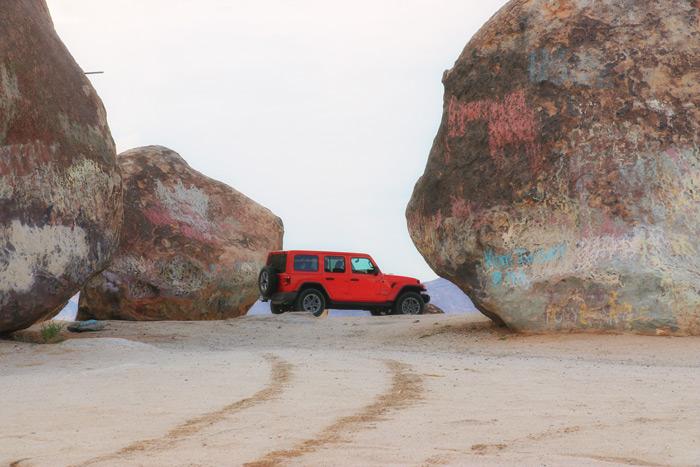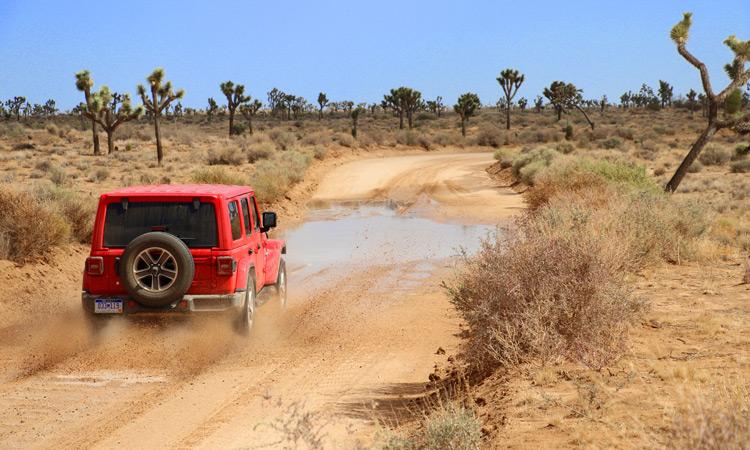We all know that proper tire pressure is essential to keeping your daily driver safe and efficient on the road, but it's just as important when off road driving too. However, the difference in this case is that what's correct for the pavement - may not be right for the terrain you're setting out to explore. Since most of my off road adventures have been with a fleet vehicle with tires that quite honestly aren't always ideal for true off roading, I'd never really considered "airing down" or what the proper pressure even should be. My main concern was simply leaving it at the manufacturer's recommended specs. While that's a great theory, it has resulted in multiple situations where I got stuck in sand, lost traction where I might not have with the proper pressure, and of course the dreaded flat tires.
This came to a head last summer on a trip to Joshua tree where two of the three vehicles had flats during the trip. Luckily, one was able to limp home on the car tire inflator that I had brought with me.
Unfortunately, it was designed for cars and was woefully inadequate for fully inflating a tire supporting a full-sized truck. Based on that experience though, I decided that a good air compressor would be a key part of my gear for all future off road trips. Thanks to the folks over at Audew Accessories, I was able to secure a great air compressor. The Audew 150PSI Heavy Duty Double Cylinder Portable Air Compressor Pump is exactly what it sounds like and I love the fact that it can connect to either the cigarette adapter or directly to the battery terminals for full performance. Additionally, not only is it fast for inflating truck tires - but it also comes with two other nozzles designed for inflating other items such as an air mattress, inflatable rafts, and sports balls. This combo has earned it a permanent spot in my gear locker that I take all off-road trips.

The compressor itself has two cylinders so it generates an air flow of 60L/min and we were able to re-inflate our tires very quickly so we could get back on the road and have more fun.
Benefits of Proper Tire Pressure On The Road
Before this, my biggest concern with "airing down" was simply - how to air back up so I was safe at highway speeds. As you know, maintaining your proper tire pressure allows you to save money by increasing fuel economy, lessening the wear on tires, and making sure that the tires perform the way the manufacturer intended. That last point manifests itself in things like making sure the cornering, braking, and traction dynamics help to prevent you from having an accident.
Underinflated tires on the road can cause unsafe increases in heat from friction and also lead to rapid wearing. Both of those concerns can ultimately lead to premature tire failure as well.

Why "Air Down" For Off Road Driving?
It may seem counterintuitive to reduce air pressure before hitting the trails but after a few trips it becomes clear why. It's somewhat of a paradox initially, since high air pressure helps with traction on road but lower tire pressure helps traction off road.
The reason for this is that on a trail - especially one with loose sand, rocks, mud, and other obstacles - you want as much surface area to touch the ground as possible (while still maintaining safe vehicle dynamics). However, as we'll see below - this is not a one-size-fits-all type of situation and it will require some trial and error.
Off Road Benefits of Reducing Air Pressure In Your Tires
Traction - more surface area touching the ground makes your vehicle more stable
Comfort - because the tires are softer when they hit an obstacle, you'll notice that the ride is a bit less stiff
Resistance to Puncture - ultimately, nothing is going to prevent tires from getting a leak. However, by reducing air pressure it increases the likelihood that the rubber can resist a sharp object. This is especially true for sharp rocks like those that I encountered while exploring the Old Dale Mining District and Berdoo Canyon Trail.

Safety Concerns When Reducing Tire Pressure Before Hitting the Trails
One of the biggest safety concerns is simply making sure that you always inflate your tires properly before returning to the road. Underinflated tires can be very dangerous for driving on roads! However, other safety concerns to keep in mind when airing down your tires is that it can cause your tires to get knocked off the rim since you've reduced the pressure holding it in place. Some off road enthusiasts invest in beadlock wheels to avoid this trouble but you can also reduce the risk by being conservative in how much pressure you reduce. The key here is to match the air pressure in your tires to the type of off road driving you're planning to do.
Additionally, as your tires deflate you will notice that you are losing ground clearance as well. Make sure to take that into consideration too.

What Tire Pressure Should I Air Down To?
There's no set answer here since the exact answer depends on the type of vehicle, tires, wheels, trail conditions, and the expertise of the driver. That being said, what you can do to get a better understanding of your particular vehicle's dynamics is to air down to various levels and test the performance. However, ideally you should do so when you have a buddy with you or where you are close to a tow if you end up going too low and knocking the tire off it's bead or damaging something.
Generally, for most off road vehicles 15-20 PSI is a good starting point compared to 35 PSI +/- found on most stock tires. For very soft sand - such as dune running - 10 PSI may be optimal but at tire pressures that low, you are risking the tire coming off the bead.
Remember what I saw earlier about the proper tire pressure to air down to depending on the tires? That's something you shouldn't ignore.
Like the 2018 Jeep Wrangler we used for this article, most stock / OEM tires that come on your off road vehicle are "All Weather" or "All Terrain" tires vs "Off Road" tires. This generally means that they will generally have weaker sidewalls compared to tires that are truly designed to perform off road. I understand that the manufactures have optimized each vehicle today to get the maximum mpg rating but you need to consider that when looking at how low to go as well. As a result, when choosing to air down your OEM tires for specific terrain, remember to balance the benefits vs potential damage to your tires if you don't do it correctly.
